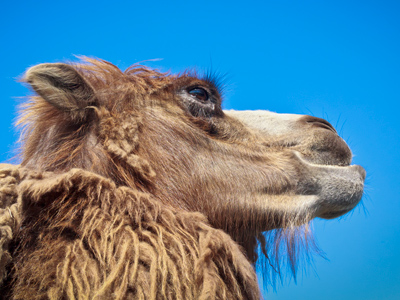
Ask the AI Tutor
Need help with Adaptation? Ask our AI Tutor!
AI Tutor - Lucy
Connecting with Tutor...
Please wait while we establish connection

Bushy eyebrows protect camels from their sandy habitat.
Adaptation
Animals and plants adapt to survive. Adaptations may be physical, like a polar bear’s thick fur, or behavioral, like birds migrating south during winter months.
1 .
Woodlands can be very dark. What do woodland plants often have so they can survive with less light?
Large flat leaves
Thin spiky leaves
Pale green leaves
No leaves
Having large flat leaves helps plants to absorb as much sunlight as possible
2 .
What does adaptation mean?
Animals and plants like their habitats
Animals and plants decide to change their habitats
Animal and plant species develop characteristics over time which help them survive their habitats
Animals and plants learn to thrive in their habitats
Individual animals and plants which have characteristics allowing them to cope with their habitats are more likely to survive and breed than other individuals. Over time, the species changes. This process is called natural selection
3 .
Many mammals living in the Arctic have fur which changes in what way over the course of the year?
It becomes white in the late spring
It grows thicker in the summer months
It completely falls out in the summer
It changes colour in the winter
The fur of many Arctic mammals becomes white in the winter, helping them to blend in with the snowy landscape
4 .
Fawns (baby deer) have spotted coats. This adaptation is suited to which habitat?
The seashore
Mountains
Desert
Woodland
Their spotted coats help fawns to blend in with the dappled shade found in woodlands - fawns have also adapted to have no scent, making it much harder for predators to find them!
5 .
Cacti have adapted to live in some of the driest habitats on earth. Which of the following characteristics helps the cactus survive with little rainfall?
A shallow, widespread root system
Green bark
Colourful flowers
Large leaves
Cacti have shallow, widespread roots in order to take up as much rainfall as possible. In addition, some cacti can even grow roots very quickly when it is raining. These roots then die off when the ground dries out again
6 .
Many woodland birds have adapted short wings. What advantage does this give them?
Short wings help birds fly quietly
Short wings help birds fly between trees
Short wings help birds find more food
Short wings keep birds cooler in the summer
Birds with large wings are poorly adapted to woodland
7 .
What adaptation do sharks and penguins share?
They both have fins for swimming
They both have streamlined bodies for swimming
They both have feathers for warmth
They both have gills for breathing under water
Sharks don't have feathers and penguins don't have gills. Penguins don't have fins either - their wings have evolved into flippers
8 .
Zebras live in large herds in a grassland habitat. How does a striped coat help them survive this habitat?
The white stripes help a zebra's fur trap the sun's warmth
The stripes make the zebras easy to spot for predators
The stripes help the zebras to cool down at night
The stripes are useful as camouflage
Zebras' coats are camouflaged to blend in with the rest of the herd. Scientists think that the zebra's stripes confuse predators, who have difficulty focussing on an individual zebra long enough to capture it
9 .
Which adaptations in camels do not protect them from their sandy habitat?
A double row of long eyelashes
Bushy eyebrows
A long neck
Nostrils which can close
The eyebrows and eyelashes keep sand out of the camel's eyes and the nostrils keep it out of the nose
10 .
Which of these features protects seaweed from being damaged by powerful waves?
Seaweed's green colour
Seaweed's toughness and flexibility
Seaweed's slimy texture
Seaweed's nutritional value
Seaweed has adapted to survive the difficult conditions found near rocky seashores
**Unlimited Quizzes Await You! 🚀**
Hey there, quiz champ! 🌟 You've already tackled today's free questions.
Ready for more?
Ready for more?
🔓 Unlock UNLIMITED Quizzes and challenge yourself every day. But that's
not all...
not all...
🔥 As a Subscriber you can join our thrilling "Daily Streak" against other
quizzers. Try to win a coveted spot on our Hall of Fame Page.
quizzers. Try to win a coveted spot on our Hall of Fame Page.
Don't miss out! Join us now and keep the fun rolling. 🎉
**Unlimited Quizzes Await You! 🚀**
Hey there, quiz champ! 🌟 You've already tackled today's free questions. Ready for more?
🔓 Unlock UNLIMITED Quizzes and challenge yourself every day. But that's not all...
🔥 As a Subscriber you can join our thrilling "Daily Streak" against other quizzers. Try to win a coveted spot on our Hall of Fame Page.
Don't miss out! Join us now and keep the fun rolling. 🎉






